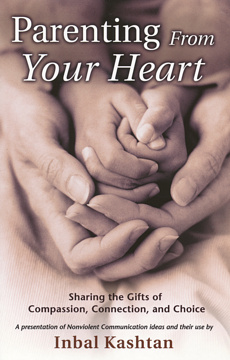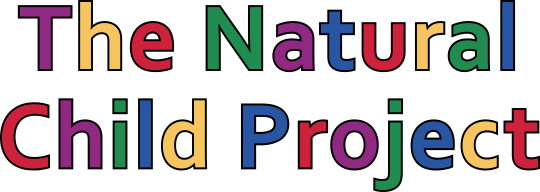When a Child Says "No"
"NO!"
The dreaded word has been spoken. You asked your child to do something reasonable, like put on sunscreen on a hot, sunny day. Wash his hands before a meal. Put his shoes on so you can get out of the house. Pick up the toys he left scattered in the living room. Brush his teeth before going to bed. Go to bed.
Yet your child - at a year, two, three, four or older - has a mind of his own. You love that mind of his, his growing independence and assertiveness, his desire to decide what he wants to do and when. But you wish he would be reasonable! You wish he would do, without so much fuss, what you want him to do.
Negotiating the gap between what we want and what our children want can strain our patience and skill level to their limit. Parenting books attest to this, as one after another focuses on how to get our children to do what we want them to do - whether through "effective discipline," rewards, punishments, or dialogue.
Nonviolent Communication (NVC) offers a perspective and skills that take the dialogue approach further and deeper than any other process I've encountered. The premise underlying NVC is that all human actions are attempts to meet our human needs, and that understanding and empathizing with these needs creates trust, connection, and more broadly - peace. This premise is translated into a very concrete and practical set of tools for communication that increases our ability to recognize and empathize with our own and others' feelings and needs. When used consistently (or even occasionally!), NVC can create deep connection, trust and cooperation among family members of all ages.
An NVC dialogue
Recently, a parent asked me about a struggle very familiar to most parents of toddlers and young preschoolers. Wanting to know how she might deal with a "no" from her 2-year-old without resorting to force, she described the following situation:
"Sometimes my daughter refuses to get into the car seat, in which case we 'force' her in. This issue involves protecting my child from harm. But it could be argued that we could simply choose to wait and not go anywhere in the car until we can talk her into getting in herself. However, like most people, we are always rushing around, and waiting is very rarely a practical option."
An NVC dialogue may or may not help the parent solve this problem quickly, but it will certainly support her in having the quality of relationship she wants to have with her child. If she chooses to take the time to connect with her child (which sometimes does move things more quickly) the dialogue might look something like this:
Parent: "Hey, it's time to leave to go to Grandpa's."
Child: "NO! NO! NO!"
Parent: "Are you enjoying what you're doing and want to continue doing it?" (Instead of hearing the "no," the parent hears what the child is saying "yes" to by guessing her feelings - pleasure, and her needs - play and choice.)
Child: "YES! I want to keep gardening!"
Parent: "You're really having fun gardening?"
Child: "Yes!"
Parent: "I'm enjoying seeing how fun it is for you. I'm worried because I like getting to places when I say I will." (Instead of coming back with her own "no," the parent expresses her feelings and her need for responsibility.)
"If we want to get to Grandpa's when I told him we'll be there, this is the time to leave. So would you be willing to get into the car seat now?" (Mom ends with a request that lets her daughter know what Mom would like at this moment that may help Mom meet her needs.)
Child: "NO! I want to garden now!"
Parent: "I'm confused about what to do. I like when you do things you enjoy, and I also want to do what I said I was going to do." (Mom is showing her daughter that she cares about meeting both their needs.)
"Would you be willing to go into the car seat in 5 minutes so we could get there soon?" (Mom offers a strategy that might meet both their needs, again in the form of a request.)
Child: "OK."
Or maybe it wasn't that easy...
Child: "NO!!! I don't want to go! I want to stay home!"
Parent: "Are you very frustrated now? You want to choose what you are going to do?" (Mom connects with her daughter by showing her understanding and acceptance of her daughter's intense emotions and need for autonomy.)
Child: "Yes! I want to garden!"
Parent: "I see. I'm feeling sad because I want to make plans that work for everyone. Would you be willing to think with me about some ideas of what to do that would work for both of us right now?" (Again, Mom expresses her care for meeting both their needs and comes up with a new strategy that might also meet her daughter's needs for choice and autonomy.)
Child: "OK."
Depending on the child's age, ideas for strategies to meet everyone's needs might come from the parent with feedback from the child, or from both people. My son started coming up with strategies to meet all of our needs before his third birthday, often innovative and workable ones we had not considered.
Even if the child still says "no" at this stage, NVC continues to offer options for dialogue that deepen connection. With repeated experiences that give the child confidence that adults respect his needs as well as their own, he will steadily develop greater capacity for considering others' needs and acting to meet them.
Meeting needs as the basis of strategies
In using NVC, we focus on how to meet all of our needs, sometimes postponing decisions until we have made a connection with each other that will be the basis for a solution. Having connected, the parent and child working on the car seat situation might come up with a variety of strategies, depending on which needs are most alive for them. The parent might realize that she could meet her need for responsibility by calling Grandpa and making the date an hour later. She might choose to meet her need for consideration by expressing her feeling and needs more passionately and seeking understanding from her daughter. Or she might connect with her needs for harmony and ease and choose to change the plans. If the plans are changed out of a clear choice to meet needs, this is quite different from "giving in" to the child's "whims."
Connecting with the child's needs might yield other strategies. The child might have a passionate need for play, which might be met by coming up with a plan for what she'll do when they get to Grandpa's. She might have a powerful need for autonomy, which might be met by leaving it up to her to decide when she's ready. She also has a need for contributing to other's lives. If the parent finds a way to express her own feelings and needs and make clear requests to her daughter, she might help her daughter connect with her intrinsic need to contribute to others so that it becomes the child's choice to get into the car seat rather than a "power struggle" which she lost.
In any case, when the parent persists with honestly expressing her feelings and needs and empathizing with her daughter's feelings and needs, mother and daughter will build the skills they need to find strategies that work for them throughout their lives.
What difference does hearing "yes" make?
When our children say "no" and we hear "no," we are left with two often unsatisfying options: Either we accommodate their "no" or we override it. When we choose to transform our children's "no" into an understanding of the "yes" behind it, we gain deeper insight into what motivates our children's actions: needs that are shared by all human beings.
Understanding our children more deeply, we usually feel more connected to them and they to us. People who are connected have a greater capacity to think creatively about strategies to meet their needs, extend their goodwill toward one another, and exercise more patience and tolerance when their needs are not met in the moment. In my family, this does not mean that we always solve everything easily. But it does mean that we nearly always nurture our connection through these dialogues, and that we trust one another deeply with our feelings and needs. This is the quality of relationship that I want with both my child and my partner.
Changing our responses to our children's "no" means, in part, letting go of the power we have over our children by relinquishing (or at least reducing) our own "no" to them. It means being willing to let go of our attachment to our strategies based on understanding our own and our children's needs. It means focusing on the nature of the relationship we want to have with our children, what we want to teach them, and what kind of world we want to prepare them for.
Yet using NVC does not mean giving up on meeting our needs! Our deep human needs matter, and we have powerful tools with which to meet them: expressing our feelings and needs passionately, and learning to identify what it is we would like that would meet our needs without an attending cost for our children. Without blaming, shaming, or demanding acquiescence, we can meet our needs by connecting with ourselves and our children.
There is a risk to making requests of our children instead of demands or ultimatums: They just might say
"no," and we might think that we have to accept it. Of course, we haven't lost much, because
children often say "no" even to our demands! How delightful, then, to discover that by hearing the
"yes," we gain freedom to not take "no" for an answer. We can use a "no" (from
our children, our partners, ourselves) as the beginning of a rich dialogue that can bring all of us closer and
move us in the direction of meeting all of our needs.

A version of this article appears in the booklet Parenting from Your Heart: Sharing the Gifts of Compassion, Connection, and Choice by Inbal Kashtan, published by Puddle Dancer Press.
Inbal's audiobook, "Connected Parenting: Nonviolent Communication in Family Life" is available from Bay Area Nonviolent Communication.
For more information, see Marshall Rosenberg's Articles and the Center for Nonviolent Communication.
Reprinted with permission of the author. Copyright © 2002 Inbal Kashtan.




